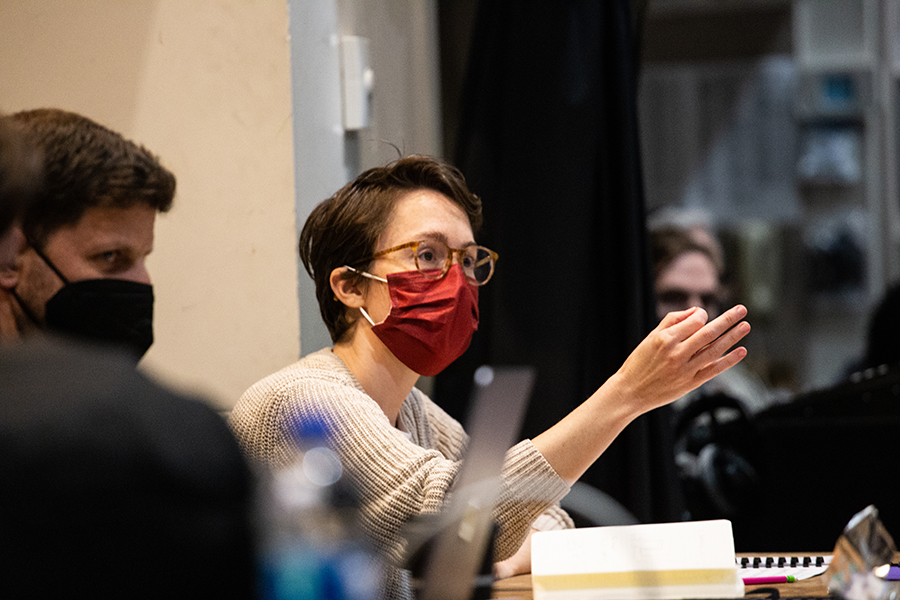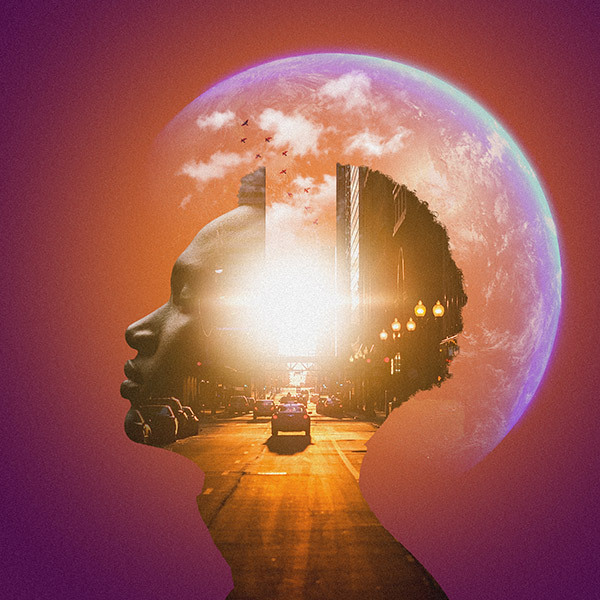March 10, 2023
Notes on Four Portraits
First the Music.
The two central figures A and B appear in four different frames. The music reflects and refracts humor, yearning, and frustration with the sounds of the particular environment of each scene. The glitch of an ever-disrupted phone connection becomes scrambled woodwinds and fragmented vocals. The commuter train's "doors open" announcement, the screech as it veers around a bend, and the chattering inner worlds of passengers. Alone in a car, the GPS's electronic presence hovers over a pattern of rising chords. And in the forest, the murmuring choir shimmers like the leaves of an aspen, the distant echoes of familiar voices just beyond reach. The musical structures are inspired both by organic material (mycelial fibers, the phloem of trees) and the architecture of our digital lives.
Then This.
"Loneliness is a subjective sense of being disconnected from others, and not having close and supportive relationships with people. This feeling of being alone is distinct from social isolation, which measures the amount of time a person actually spends alone, meaning that a person can be surrounded by people and still experience loneliness."
Loneliness: Human Nature and the Need for Social Connection, John T. Cacioppo and William Patrick
Professor John T. Cacioppo, founder of the University of Chicago Center for Cognitive and Social Neuroscience, has studied loneliness for two decades. He has discovered that loneliness is contagious and heritable, and that one in four people regularly feel lonely. It increases the odds of an early death by 20%.
"I can remember exactly the year eye contact stopped."
Cacioppo and Patrick
Cacioppo believed loneliness is also treatable, like any other human condition, and pioneered several treatments before his death in 2018. One of his treatments is retraining people in reciprocity in communication—how do they read voices, how do they read eyes, how do they read posture—and then teaching them to analyze and develop different ways of (re)building strong relationships with those around them.

Composer Caroline Shaw in an early workshop for Four Portraits
That.
"If you look at roadside embankments, you might be able to see how trees connect with each other through their root systems. On these slopes, rain often washes away the soil, leaving the underground networks exposed. Scientists in the Harz mountains in Germany have discovered that this really is a case of interdependence, and most individual trees of the same species growing in the same stand are connected to each other through their root systems. It appears that nutrient exchange and helping neighbors in times of need is the rule, and this leads to the conclusion that forests are superorganisms with interconnections much like ant colonies."
The Hidden Life of Trees, Peter Wohlleben
The Other.
In an article published in 1970, Japanese professor of robotics Masahiro Mori hypothesizes that the more a robot resembles an actual human, the more empathetic and positive the emotional response of the observer becomes — until the resemblance reaches a certain point. At this point, the observer's positive and empathetic emotional responses quickly turn into uncanny or strangely familiar feelings of uneasiness and revulsion. But as the robot's appearance continues to become even more human, the positive emotions return, and the level of empathy between observer and robot approaches the level seen in interactions between human beings. Mori identifies this cognitive phenomenon as 不気味の谷, which was translated into English in 1978 as the "uncanny valley" in the book Robots: Fact, Fiction, and Prediction by Jasia Reichardt. The "valley" denotes a dip in the human observer's affinity for the replica, a relation that otherwise increases with the replica's human likeness.
Charles Darwin has a similar experience when he encounters an unusual snake in his own uncanny valley in 1839: "The extremity of the tail of this snake is terminated by a point, which is very slightly enlarged; and as the animal glides along, it constantly vibrates the last inch.[...] As often as the animal was irritated or surprised, its tail was shaken; and the vibrations were extremely rapid. Even as long as the body retained its irritability, a tendency to this habitual movement was evident.[...] The expression of this snake's face was hideous and fierce; the pupil consisted of a vertical slit in a mottled and coppery iris; the jaws were broad at the base, and the nose terminated in a triangular projection. I do not think I ever saw anything more ugly, excepting, perhaps, some of the vampire bats. I imagine this repulsive aspect originates from the features being placed in positions, with respect to each other, somewhat proportional to those of the human face; and thus we obtain a scale of hideousness."
The Voyage of the Beagle, Charles Darwin

